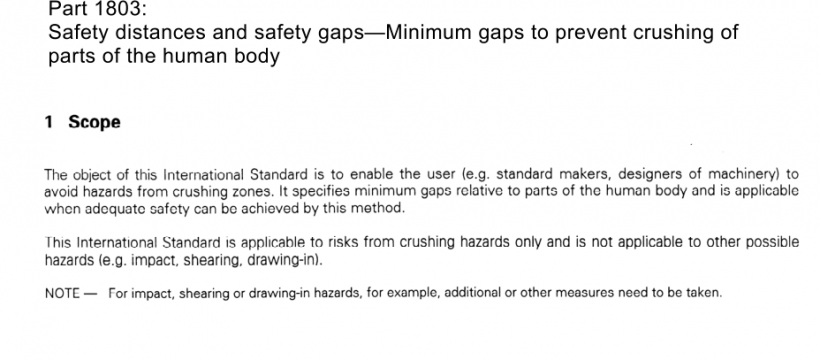AS NZS 4024.1803:2014 pdf free download
AS NZS 4024.1803:2014 pdf free download.Safety of machinery
4.1 Methodology for the use of this International Standard
Standard shall form part of the iterative safety strategy outlined in clause 5 The method of using this nternationa “Strategy for selecting safety measures” of lSO/rR 12100-I : 1992.
The user of this International Standard shall:
a) identify the crushing hazards;
b) assess the risks from these hazards in accordance with lSO/TR 12100-1, paying particular ttention to the following:
– where it is foreseeable that the risk from a crushing hazard involves different parts of the body, the minimum gap given in table 1 relating to the largest of these parts shall be applied [see also d)],- the unpredictable behaviour of children and their body dimensions if children are included in the population at risk,
– whether parts of the body could enter the crushing zone in a configuration other than those indicated in table 1,
– whether thick or bulky clothing (e.g. protective clothing for extreme temperatures) or tools have to be taken into account,
– whether machinery will be used by persons wearing thick-soled footwear (e.g. clogs) which will increase the effective dimension of the foot;
c) select from table 1 the appropriate minimum gap relating to the body part at risk (see also annex A);
d) if adequate safety cannot be achieved by the minimum gaps selected from table 1, other or additional measures and/or means shall be used (see e.g. lSO/TR 12100-1, ISOnR 12100-2 and IS0 13852).
If the minimum gap for the largest expected body part cannot be achieved, the following example gives one particular means of restricting access to smaller body parts.
Access of larger body parts to the crushing zone can be prevented by the use of protective structures having a restricted opening, as indicated in figure 1.
The possibility of access to a crushing zone for a particular part of the body is dependant on the following:
– the gap a between the fixed and moving part or between two moving parts;
– the depth b of the crushing zone;
– the dimensions c of the opening in the protective structure and its distance d from the crushing zone.
NOTE – The dimensions for openings in relation to safety distances can be found in IS0 13852.
For certain applications there may be justifiable reasons to deviate from the minimum gaps in table 1.Standards dealing with these applications indicate how adequate safety can be reached.
AS NZS 4024.1803:2014 pdf free download
